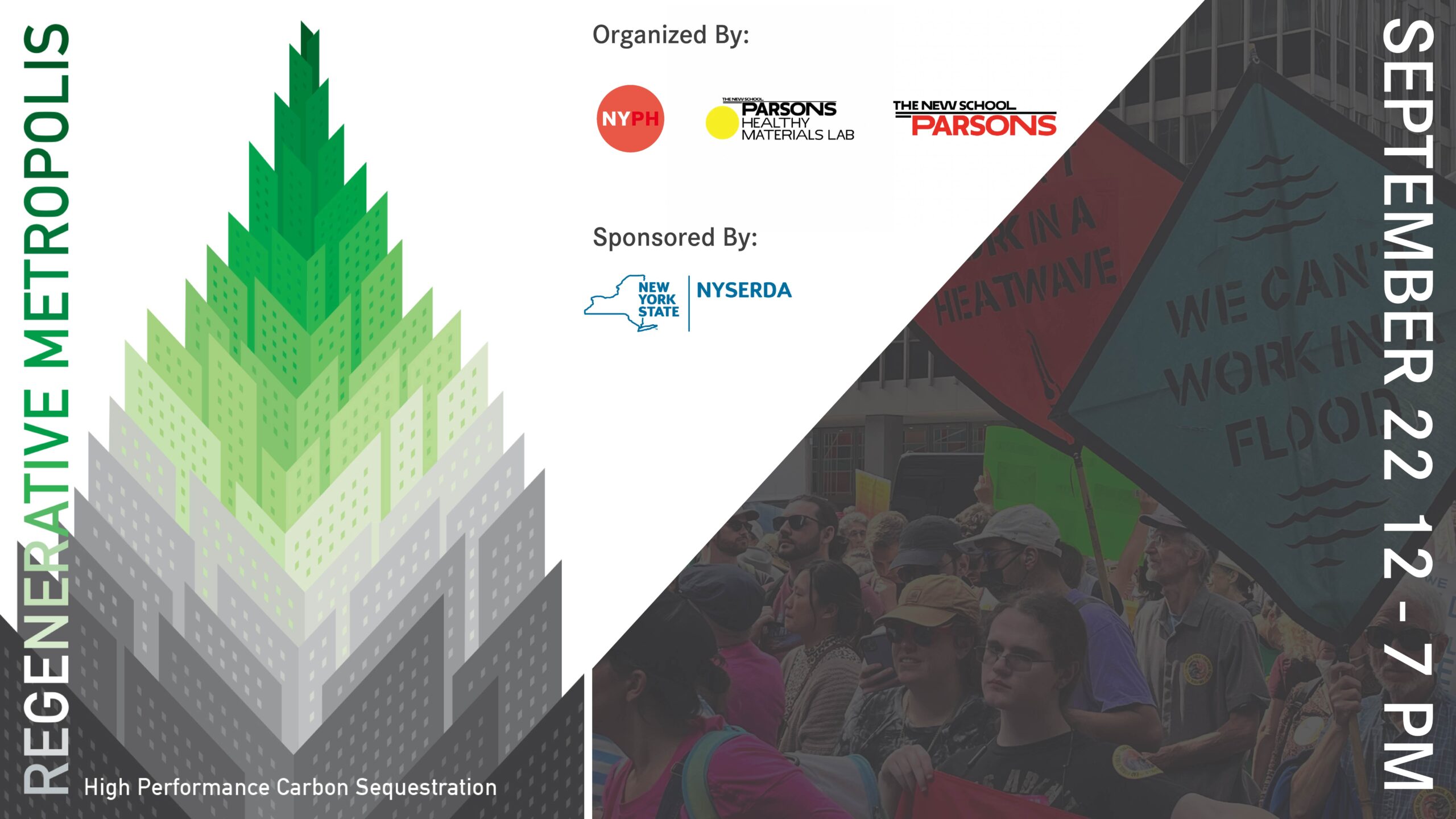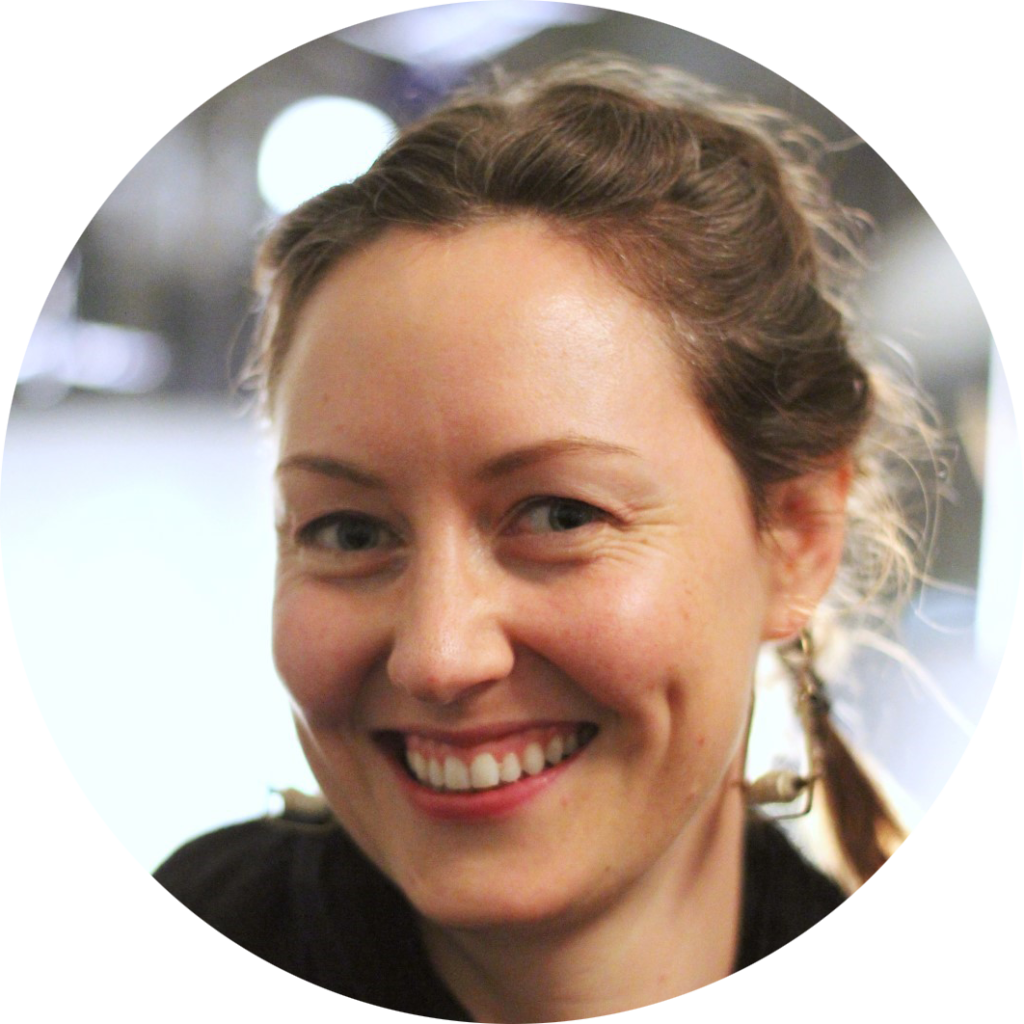
- This event has passed.
Regenerative Metropolis: High Performance Carbon Sequestration
September 22, 2023 @ 12:00 pm - 7:00 pm

Design: Melinda Beck
Cities such as New York are at serious risk from climate change, and have the power and responsibility to take the lead on solutions. This Symposium will explore potential scalable regenerative technologies for the world’s largest urban constructed environments. The material science of carbon storing building components is receiving much needed attention, but scalable solutions need wider adoption and development. The building industry is focused on reaching carbon neutrality in operations and construction, taking a holistic view of the enormity of this responsibility. Passive House energy efficiency coupled with scalable carbon storing materials for widespread use and large urban contexts, can provide the solution humanity needs and deserves now. Join us as we explore the emerging tools, policy, start-up financing, and material science around embodied carbon in high performance architecture.
DATE: September 22, 2023
TIME: 12 PM - 7 PM
VENUE: Parsons School of Design - University Center, 63 Fifth Avenue

Doors open at 11:30 AM
- Coffee & Refreshments
- Registration
12:00 - 1:15 PM - Welcome & Keynote

Welcome by David J. Lewis, Dean, School of Constructed Environments
David J. Lewis is the Dean of The School of Constructed Environments, Professor of Architecture, and a founding principal of LTL Architects (Lewis.Tsurumaki.Lewis), a design intensive architecture firm located in New York City. At Parsons he has served as Director of the Master of Architecture program, the Director of Design Workshop program, and on the faculty since 2002. He leads courses on the intersection of architectural representation, material practices, and history.

Introduction
- Alison Mears, Director, Healthy Materials Lab
- Andreas Benzing, Executive Director, New York Passive House
- Sara Bayer, Event Chair, New York Passive House

Keynote by Felix Heisel, Director, Circular Construction Lab
Felix Heisel is Assistant Professor and the Director of the Circular Construction Lab at Cornell University’s College of Architecture, Art, and Planning. He is a faculty fellow at the Cornell Atkinson Center for Sustainability, and a graduate field member in architecture, systems engineering and matter design computation. Heisel is a licensed architect in Germany and partner of 2hs Architekten und Ingenieur PartGmbB, an office specialized in the development of circular prototypologies.
1:15 - 2:45 PM - Regenerative Materials
Architecture can actually remove excess carbon dioxide gas by deploying materials that solidify it from the atmosphere either by photosynthesis or carbonization. Many of these products are available today and can also contribute to a critical drawdown solution of regenerating soil health. This session will explore the use of these materials in an urban metropolis setting.

Introduction by Bruce King, Founder & Director, Ecological Building Network
Bruce King is the author of The New Carbon Architecture and Build Beyond Zero with Chris Magwood, and has been a structural engineer for 45 years, designing buildings of every size and type all over the world. He is also author of the ASTM standard for earthen construction, the Marin County Low-Carbon Concrete code, Design of Straw Bale Buildings, and other books. He is also Founder and Director of the Ecological Building Network (EBNet), a non-profit information resource that is launching BuildWell Media to develop and disseminate free online video and teaching resources on climate-friendly building.

Moderator
- Sara Bayer, Event Chair, New York Passive House

Matthew O’Malia, Co Founder & Vice President, Timber HP
GO Lab founder and partner Matthew O’Malia is principal architect and co-founder of GO Logic and OPAL, an award-winning architecture firm with a nationwide reputation for innovation and expertise in the design of high performance residential and institutional buildings. A leader in Passive House design in the U.S. and named to Architect magazine’s Architect 50 list in 2018, Matthew is a frequent speaker at sustainable design conferences in the U.S. and abroad.

Mattie Mead, Founder & CEO, Hempitecture
Matthew (Mattie) Mead is the founder and CEO of Hempitecture, a building materials manufacturer that uses biobased, carbon-capturing inputs to create healthier, high-performing products for a more sustainable planet. An Idaho-based, adventure-seeking entrepreneur, Mattie has a passion for re-envisioning the materials traditionally used in construction and beyond. On a mission to discover tangible solutions to the climate crisis, Mattie founded the Hempitecture concept in 2012 during his studies of architecture, environmental sciences, and entrepreneurship at Hobart College in Geneva, New York.

Louis P. Grasso Jr., LEED AP, Lead Inventor of Pozzotive®
A Founding Partner of Urban Mining Industries, LLC and Chief Executive Officer of Urban Mining CT LLC, a licensed regional producer of Pozzotive®. Louis has over 35 years of experience combined in commercial construction and development Lead Inventor and in the manufacturing, marketing and distribution of masonry products. As the of Pozzotive® including several US Patents regarding Ground Glass Pozzolans for use in concrete, he has committed over 20 years of his professional career toward the commercialization of the product. Louis is responsible for new product and plant development, operations and ongoing efforts to educate the design, development and construction industries on the benefits of Pozzotive® and to strengthen the Pozzotive® brand.

Traves W. Ogilvie, Business Manager, Aero Aggregates
Traves is the Composites Business Market Manager for Aero Aggregates. With a background in technical sales, marketing, and construction management, Traves brings nearly 30-years of building systems, engineering, and building products experience and industry expertise to the team. Traves worked with one of the leading global producers of expanded glass as the Director of Sales for the USA & Mexico for approximately 6 years prior to joining Aero. During these years, Traves worked together with some of the largest producers of Cementitious and Polymer based building products in North America providing technical support and participating in product development trials. Traves has been a member of the United States Green Building Council since 2009 and is a LEED BD+C (Building Design & Construction) Accredited Professional (AP).
2:45 - 3:00 PM - Break
3:00 - 4:00 PM - Metropolis Performance: Whole Life Carbon Balance
The high-performance architecture of Passive House may use more enclosure materials to construct but their mechanical systems can be smaller, reducing embodied carbon in that respect. Additionally, their impact on the electrical grid’s peak loads improves resiliency and facilitates the conversion to renewables. This session will highlight the building systems role in a whole carbon picture.


Moderator
- Sara Bayer, Event Chair, New York Passive House
- Buck Moorhead, Chair, New York Passive House

Nikita Jathan, LEED AP BD+C, WEDG, Senior Environmental Designer, Atelier Ten

Edward C. Ettinger, P.E., LEED AP BD+C, BCxP, Managing Principal, Ettinger Engineering Associates
4:00 - 5:30 PM - Policy Roundtable: Regenerative Metropolis
Our goal with the policy component: bring forth what is currently happening with respect to embodied energy of materials in the high performance Passive House built environment at state and municipal levels (NYS and possibly beyond) and, looking forward, what might be in the works.
There is growing momentum in New York City, New York State and beyond to decarbonize building operational energy through the implementation of Passive House and other very high performance building standards. Simultaneously, there is a growing awareness and nascent momentum to address the very critical issue of significantly reducing embodied energy within building sector materials.
Panelists will present current programs in place with respect to both operational carbon and embodied carbon from their respective municipal, state, and federal level perspectives. Potential future programs may also be discussed.

Introduction by Mikhail Haramati, Carbon Neutral Buildings Fellow, NYSERDA
Mikhail Haramati is the Carbon Neutral Buildings Fellow at NYSERDA, where she leads policy development on embodied carbon. She is the co-author of the Executive Order 22 guidance on embodied carbon for NY state procurement, and the LECCLA guidance for the use and innovation of low embodied carbon concrete.
She has been with NYSERDA since 2020 where she has been part of the staff team supporting the NY Climate Action Council and Climate Act Scoping Plan and state buildings sector roadmaps. She has held positions with the CA CPUC, LBNL, and as a private consultant. Prior to joining NYSERDA, Mikhail led the Building Efficiency Research group at the CA Energy Commission, funding innovative technologies to reduce the energy use of buildings.
She has a BA in Public Policy from Mills College, an MPP in Energy Policy from UC Berkeley, a Certification in Quantitative Methods from the Evaluator’s Institute at George Washington University.

Moderator:
- Buck Moorhead, Chair, New York Passive House

Gina Bocra, RA, LEED AP BD+C/ID+C, Chief Sustainability Officer, New York City Department of Buildings
Gina Bocra brings over 20 years of experience in sustainable design, assisted with the technical development of multiple LEED rating systems, a subject matter expert on three LEED exams, and was a founding interim-officer of the National Capital Region US Green Building Council Chapter.At DOB, Gina focuses on the implementation of New York City’s Greater, Greener Buildings Plan, which addresses benchmarking, energy codes, audits and retro-commissioning, and lighting and sub metering. She leads a DOB team of specialists charged with developing procedures to enforce the Energy Code and supporting continued development of the New York City Building Code to accommodate advances in sustainability.
Gina serves as the DOB liaison to New York City’s Solar America Cities partnership led by the City University of New York and is appointed to the NY State Code Council Green Advisory Working Group.

Jennifer Bloom Leone, Chief Sustainability Officer, New York City Department of Housing Preservation & Development
As Chief Sustainability Officer for New York City’s Department of Housing Preservation & Development (“HPD”) – the largest municipal housing finance agency in the country – my work includes setting a holistic sustainability agenda and policy for the agency – ensuring that projects are low carbon, energy efficient and resilient while addressing the unique health and safety needs of the vulnerable populations we support. Included in this role is participation in numerous climate and energy working groups to represent affordable housing and ensure that this sector is able to participate in and benefit from NYC’s aggressive decarbonization agenda.

Beverly Craig, LEED AP, Program Director, Massachusetts Clean Energy Center
She works on programs including the Passive House Design Challenge for affordable housing, assists MassCEC’s workforce team, and is leading an effort related to raising awareness about upfront carbon from building materials called the Embodied Carbon Challenge. Ms. Craig comes from a background of energy efficiency retrofits and installing renewables in affordable housing, brownfields redevelopment in Milwaukee Wisconsin, and Pollution Prevention at EPA. She holds a BA from the University of Southern California and an MPP from Harvard’s Kennedy School of Government.
5:30 - 7:00 PM - Networking

Join us and connect with our presenters, professionals, and Parsons students & faculty
- Free T-shirt
- Refreshments
- Snacks

Event Organizers
- Sara Bayer, Event Chair, New York Passive House
- Andreas Benzing, Executive Director, New York Passive House
- David J. Lewis, Dean, School of Constructed Environments
- Alison Mears, Director, Healthy Materials Lab
- Buck Moorhead, Chair, New York Passive House
- Lina Yasmine Chaoui, Parsons School of Design









































